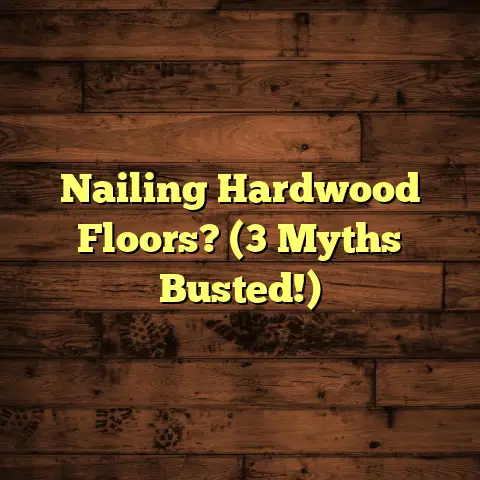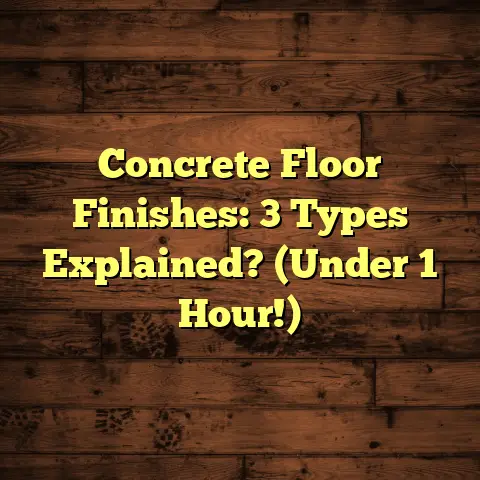Can I Resplace Just Part Of My Hardwood Floor?
When thinking about my hardwood floors, I often find myself asking the question: can I replace just part of my hardwood floor? It’s a topic that has crossed my mind several times over the years, especially when facing issues like water damage, scratches, or an outdated finish. The thought of replacing only the damaged sections is both appealing and daunting. Have you ever been in a similar situation?
The Decision-Making Process
The first time I encountered this dilemma was when I was doing some work in a client’s home. They had a beautiful oak hardwood floor that had seen better days. One section near the entrance had become worn down due to foot traffic, while the rest of the floor still looked stunning. It was tempting to suggest replacing just that part. However, I quickly realized that this decision required careful consideration.
Why Replace Just Part?
Replacing just a section of hardwood flooring can save time and money. It allows you to maintain the character and charm of your original floor while updating the damaged areas. But there’s a catch—matching the new pieces to the old can be tricky.
I remember the look on my client’s face when I explained that we might need to sand and refinish the entire area to achieve a seamless look. They were leaning toward a quick fix but ultimately appreciated my honesty about the potential challenges.
Assessing the Damage
Before making any decisions, it’s crucial to assess the damage thoroughly. Here are some questions I consider:
- How extensive is the damage?
- Minor scratches might be easily repaired with some refinishing, while deeper gouges or water damage may require more significant intervention.
- What type of hardwood do I have?
- Knowing the species and finish helps determine how easy or difficult it will be to match new pieces.
- Is it worth it?
- Sometimes, the cost of matching and labor can exceed the price of a full replacement.
During one project, I encountered a situation where a water leak had damaged several boards in a client’s kitchen. The original flooring was a unique cherry wood that was no longer available at local suppliers. This made the decision to replace only part of the floor much more complicated than it should have been.
Matching New to Old
One of the most significant challenges I face when replacing part of a hardwood floor is matching new boards with old ones. Even if you find the same species, factors like age, exposure to sunlight, and previous finishes can make new wood look out of place.
A Personal Experience
I once replaced a few planks in an old maple floor that had been installed in the 90s. The new planks were lighter and shinier than the existing flooring, which had darkened over time. To remedy this, I decided to sand down not just the new pieces but also a wider area around them before applying a stain that matched the existing wood. This took additional time but ultimately led to a more cohesive look.
Costs and Considerations
When considering whether to replace just part of your hardwood floor, understanding costs is vital.
In my experience, if you opt for partial replacement, you might face costs for:
- New materials: Depending on availability, this could be anywhere from $3 to $8 per square foot.
- Labor: If you hire someone for installation, factor in another $2 to $4 per square foot.
- Finishing: Sanding and finishing can add an extra $1 to $3 per square foot.
To make sure I stay within budget, I use FloorTally for accurate cost estimates. It pulls local prices for materials and labor, which helps me give clients realistic budgets right from the start. This transparency builds trust and keeps everyone informed.
Installation Process
If you decide to go ahead with partial replacement, here’s a brief overview of what I typically do:
- Remove damaged boards: Use a pry bar or saw to carefully take out the damaged sections.
- Prepare for new boards: Ensure that subflooring is intact and level.
- Install new boards: Fit in new pieces and secure them according to manufacturer instructions.
- Sand and finish: This is where matching becomes critical. Sand down edges and apply finish uniformly.
Maintenance Tips
After replacing part of your hardwood floor, maintaining it becomes essential to prolong its life:
- Regular Cleaning: Use a soft broom or vacuum designed for hardwood.
- Avoid Excess Water: Be cautious with mops; excess moisture can warp wood.
- Use Area Rugs: Place rugs in high-traffic areas to minimize wear.
Successes and Challenges
Throughout my career, I’ve had both successes and challenges when it comes to partial replacements. One success was when I replaced a few boards in a living room that had suffered from pet damage. The new wood blended perfectly after proper sanding and staining, leaving my client thrilled.
On the other hand, I faced challenges with a dining room project where mismatched wood grain became an issue after replacement. The solution involved selecting complementary colors rather than attempting an exact match, which ultimately led to a beautiful result.
Understanding Different Hardwood Types
Not all hardwood flooring is created equal. Understanding the various types can help you make informed decisions regarding repairs or replacements.
Solid Hardwood vs. Engineered Hardwood
Solid hardwood is milled from a single piece of wood and usually comes in thicknesses ranging from 3/4 inch to 5/16 inch. It can be sanded and refinished multiple times, making it ideal for repairs.
Engineered hardwood consists of several layers of wood veneer glued together, providing greater stability in humid conditions. However, it typically cannot be sanded down as many times as solid hardwood.
The Role of Finish in Replacement
The finish on your hardwood floor plays a significant role in how well new sections will blend with old ones.
Types of Finishes
- Oil-based Polyurethane: Durable but can yellow over time.
- Water-based Polyurethane: Dries quickly and remains clear but is less durable than oil-based options.
- Hardwax Oil: Offers a natural look and feel while being easy to maintain.
In one project, I replaced some sections of an oil-finished oak floor with new wood finished with water-based polyurethane. The difference in sheen was noticeable even after applying multiple coats, which necessitated additional sanding to ensure consistency across the entire surface.
Tools and Equipment
Having the right tools is essential for any flooring project. Here are some tools I always keep on hand for partial replacements:
- Pry Bar: For removing damaged boards without damaging adjacent ones.
- Circular Saw: Useful for cutting new boards to size.
- Sander: Essential for leveling off edges and preparing surfaces for finishing.
- Moisture Meter: To check subfloor conditions before installation.
Dealing with Subfloor Issues
Sometimes the damage extends beyond just the hardwood itself—issues with the subfloor can complicate matters further.
Identifying Subfloor Problems
Look for signs like sagging or creaking sounds when walking on the floor. If you suspect subfloor issues, it’s wise to remove some hardwood boards to assess conditions underneath.
Repairing Subfloor Damage
If you find that your subfloor is compromised, repairing it before installing new hardwood is crucial. This might involve replacing sections of plywood or reinforcing joists if they show signs of rot or damage.
Dealing with Climate Factors
Climate can significantly affect hardwood floors over time—expansion during humid months and contraction during dry months can lead to gaps or buckling.
Humidity Control
Using a dehumidifier during high humidity months can help maintain stable indoor conditions. I’ve noticed that homes with consistent humidity levels not only protect existing floors but also make replacing parts easier as they are less likely to warp.
Seasonal Adjustments
Real-Life Examples
Let me share some real-life examples from my experiences that illustrate both successes and challenges faced during partial replacements.
Case Study 1: Water Damage Repair
A client called me after discovering water damage near their kitchen sink. After assessing the situation, I removed approximately 30 square feet of damaged oak flooring. The challenge was finding an exact match for their existing flooring as they had installed it years ago.
After much searching, I found a close match at a specialty lumberyard. Once installed, I sanded the edges and applied several coats of finish. While it took extra effort to get everything looking right, my client was thrilled with how seamlessly everything came together.
Case Study 2: Pet Damage Solution
In another instance, I worked on a home where pets had severely scratched the living room floor. My approach involved replacing specific planks without having to do an entire refinishing job.
I selected planks that were slightly darker than the existing wood and used a matching stain after installation. Surprisingly, this created an interesting aesthetic contrast that my client ended up loving!
Moving Forward
As I reflect on these experiences, it’s evident that partial replacements can indeed be successful with careful planning and execution. If you find yourself needing to replace part of your hardwood floor, remember:
- Assess all options before deciding on partial versus full replacement.
- Take time to match not just species but also finishes.
- Embrace tools like FloorTally for accurate budgeting and planning.
Conclusion
So, can you replace just part of your hardwood floor? Absolutely! But it requires careful planning, assessment of damages, and sometimes a bit more effort than initially expected.
With experience under my belt and tools like FloorTally at my disposal, I can navigate these projects with confidence. Whether it’s weighing costs or deciding on finishes, having clarity helps me manage expectations and deliver quality results.
If you’re in a similar situation, remember to assess your flooring carefully and consider all your options before deciding on partial replacement. With the right approach and tools at your side, you can achieve seamless results that maintain your home’s beauty for years to come.
Final Thoughts
In closing this discussion about replacing part of your hardwood floors, it’s essential to embrace both challenges and successes along the way. Every project is unique—what works for one home may not work for another.
Feel free to reach out if you have any questions or if you’re facing your own flooring dilemmas! Sharing experiences not only enriches our understanding but also fosters community among those passionate about home improvement. Happy flooring!





